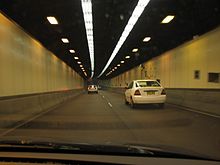Sydney Harbour Tunnel

Sydney Harbour Tunnel, northbound
|
|||||||||||||||||||||||||||||||||||
| Overview | |||||||||||||||||||||||||||||||||||
|---|---|---|---|---|---|---|---|---|---|---|---|---|---|---|---|---|---|---|---|---|---|---|---|---|---|---|---|---|---|---|---|---|---|---|---|
| Location | Port Jackson | ||||||||||||||||||||||||||||||||||
| Coordinates | 33°51′09″S 151°12′43″E / 33.85260°S 151.21187°E | ||||||||||||||||||||||||||||||||||
| Status | Active | ||||||||||||||||||||||||||||||||||
| Route |
|
||||||||||||||||||||||||||||||||||
| Start |
|
||||||||||||||||||||||||||||||||||
| End | |||||||||||||||||||||||||||||||||||
|
|||||||||||||||||||||||||||||||||||
The Sydney Harbour Tunnel is a twin-tube road tunnel in Sydney, Australia. The tunnel was completed and opened to traffic in August 1992 to provide a second vehicular crossing of Sydney Harbour to alleviate congestion on the Sydney Harbour Bridge. It is the only tunnel under the harbour, although there are plans to build a set of rail tunnels.
The tunnel joins the Warringah Freeway at North Sydney, and the Cahill Expressway at the entrance to the Domain Tunnel. It has two lanes in each direction, and runs at an angle of approximately thirty degrees (North to South) to the Sydney Harbour Bridge, which has eight lanes, with a tidal flow operation. In 2008, the tunnel was carrying around 90,000 vehicles per day.
The tunnel is made up of three sections: twin 900-metre land tunnels on the north shore, twin 400-metre land tunnels on the south shore and a 960-metre immersed tube (IMT) structure. The tunnel falls about 55 metres from the northern entrance and about 35 metres from the southern entrance to its deepest point, 25 metres below sea level.
The IMT structure consists of eight precast concrete units. The units were constructed over 100 kilometres away in a casting basin at Port Kembla and then towed to Sydney Harbour. A trench was dredged before the arrival of the IMTs and then the IMTs were lowered into the trench by a system of pontoons and control towers. After the IMTs were in place the trenches were backfilled and then a rock armour was placed over the top to protect the units against marine hazards, such as anchors or sinking vessels.
The land tunnels were constructed by a combination of driving and cut-and-cover techniques. The total construction cost of the project was A$554.25 million, and was designed to be strong enough to withstand the impact of earthquakes and sinking ships.
...
Wikipedia
